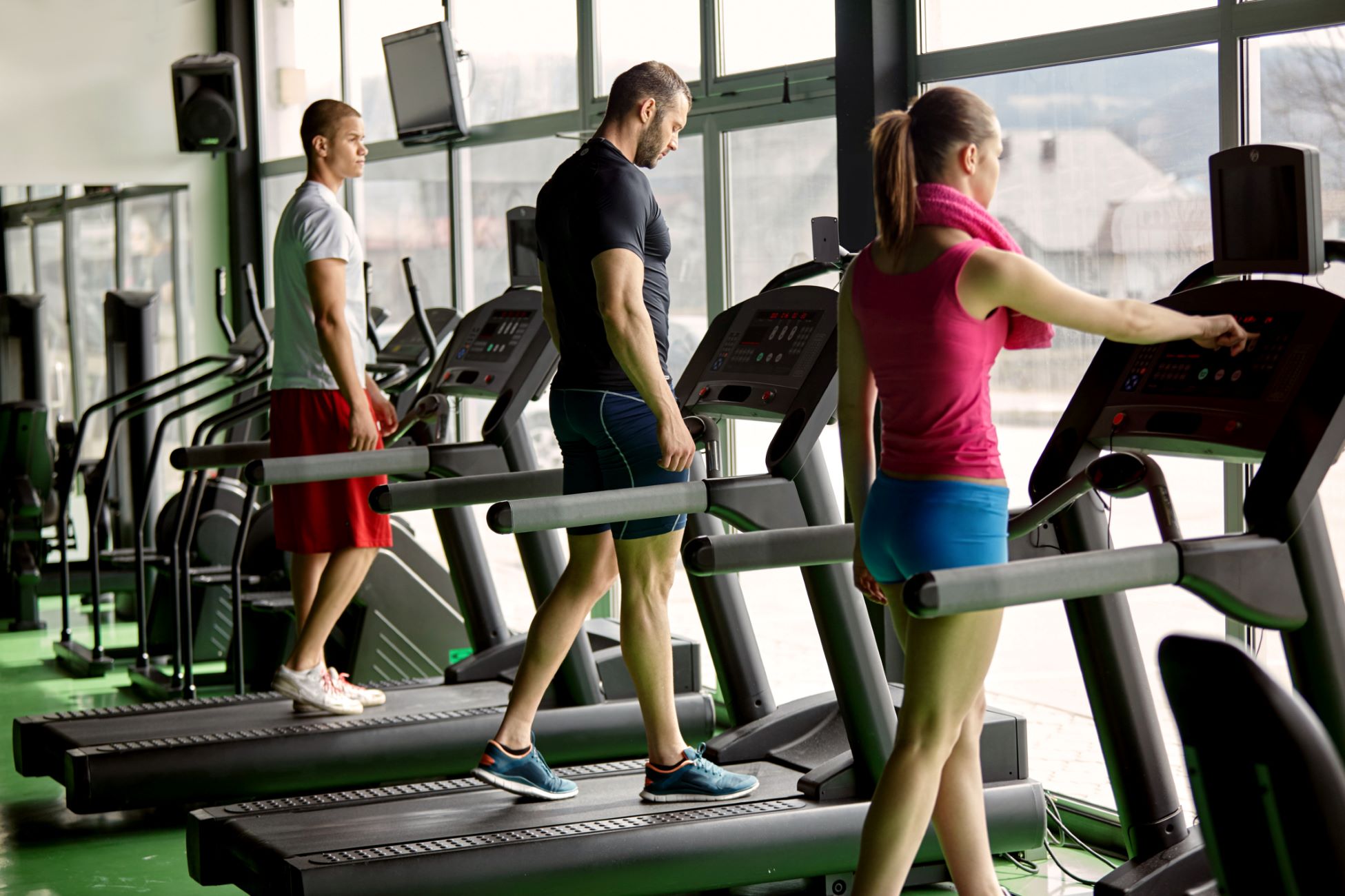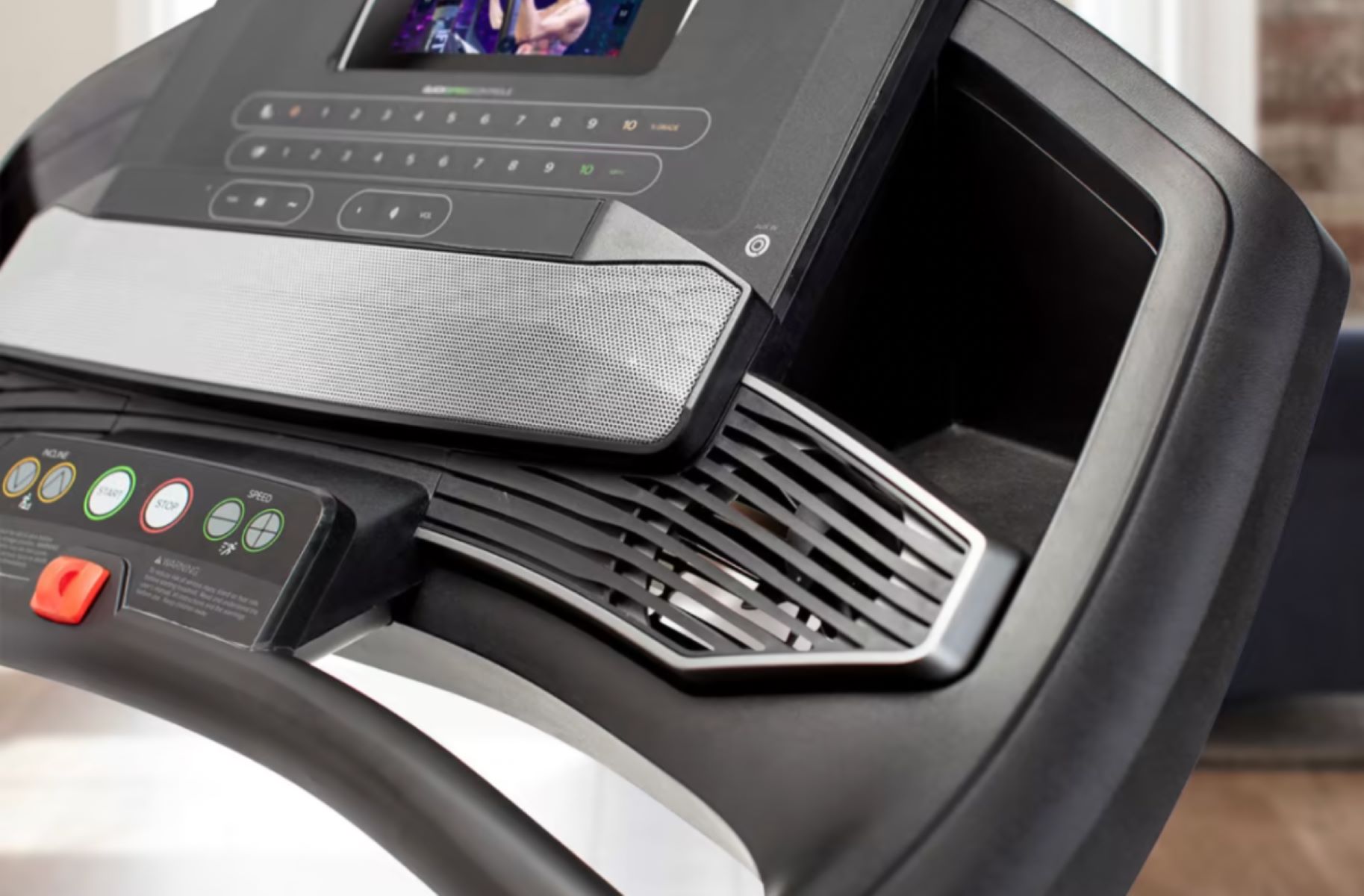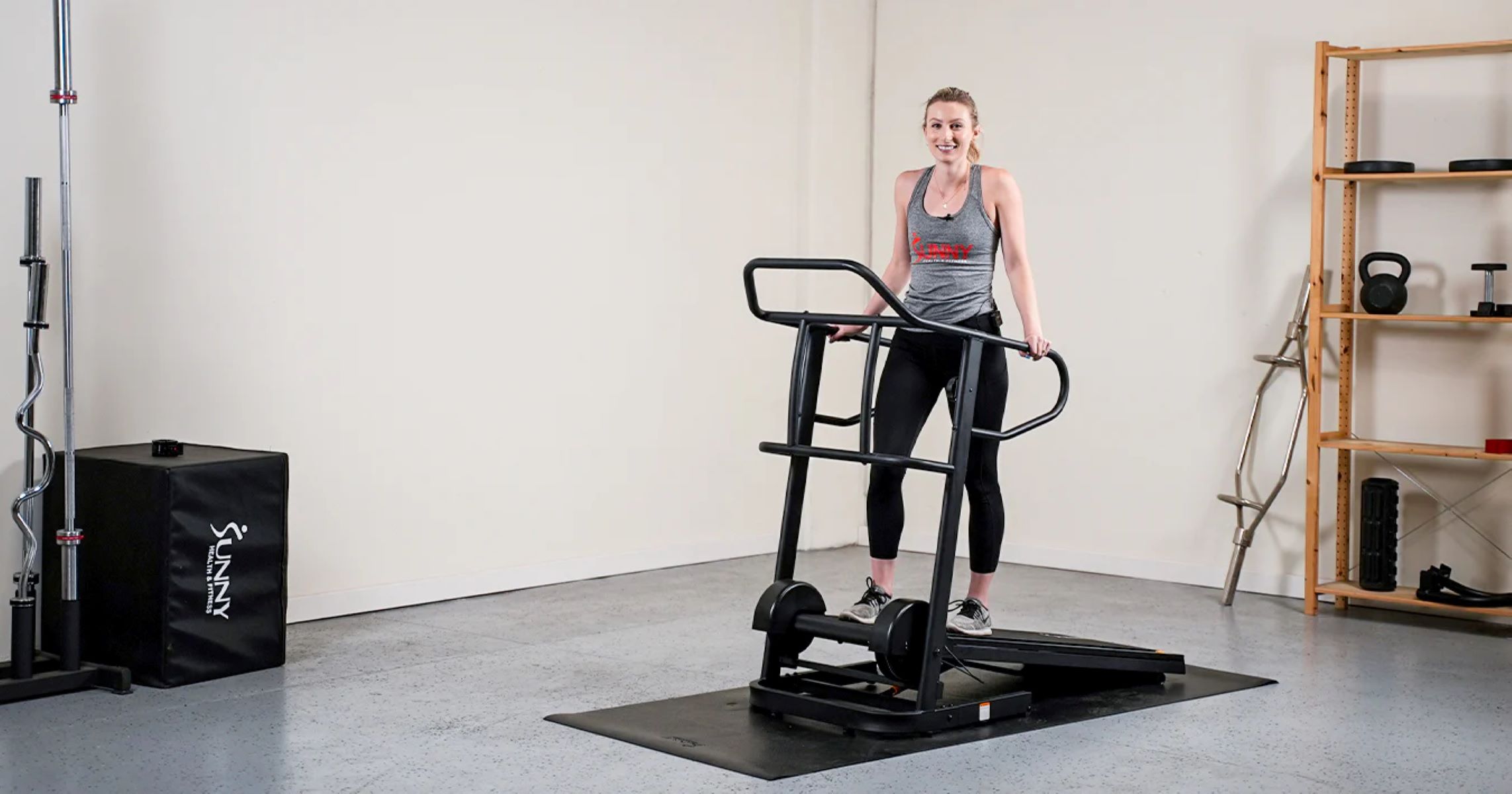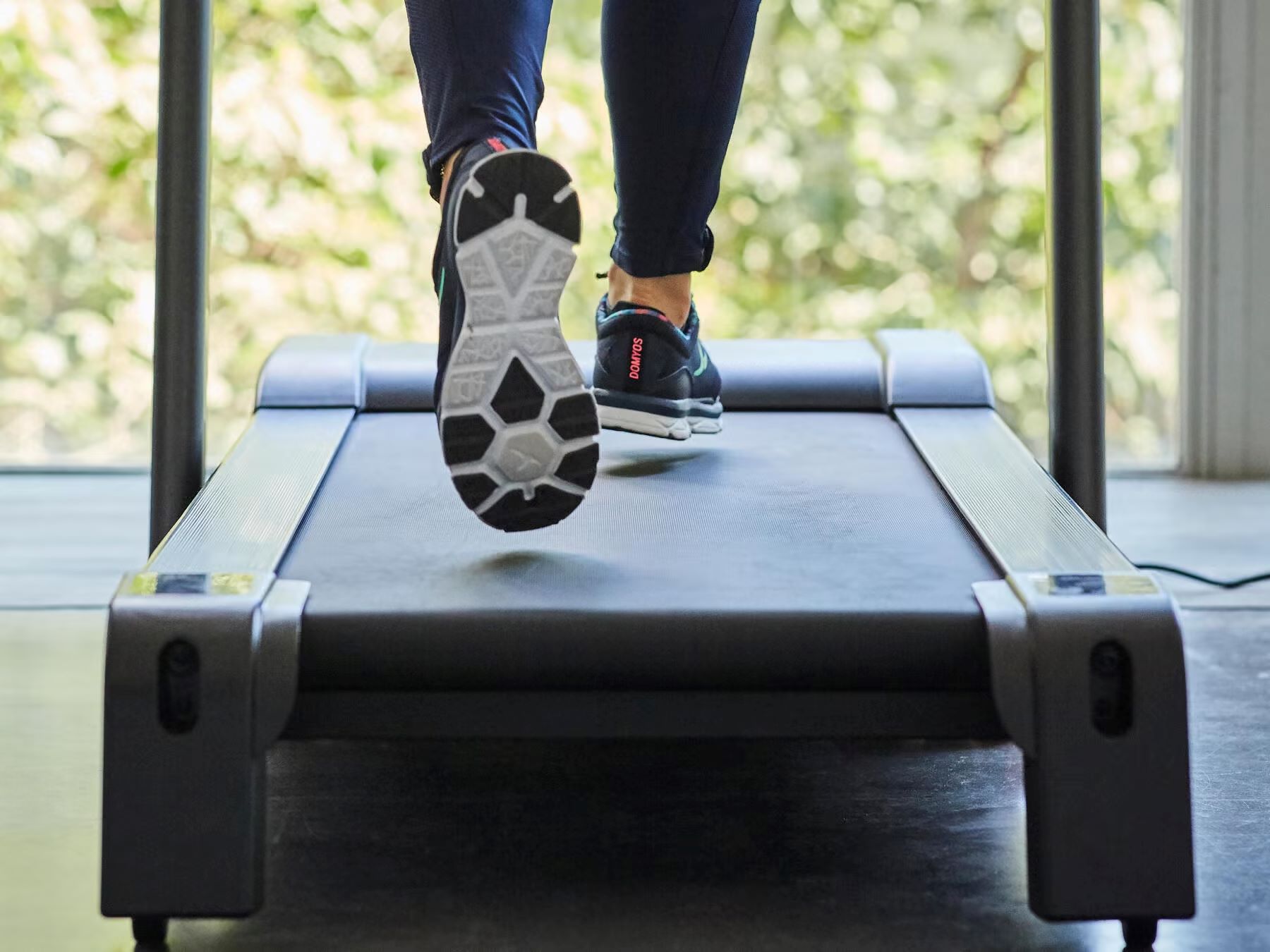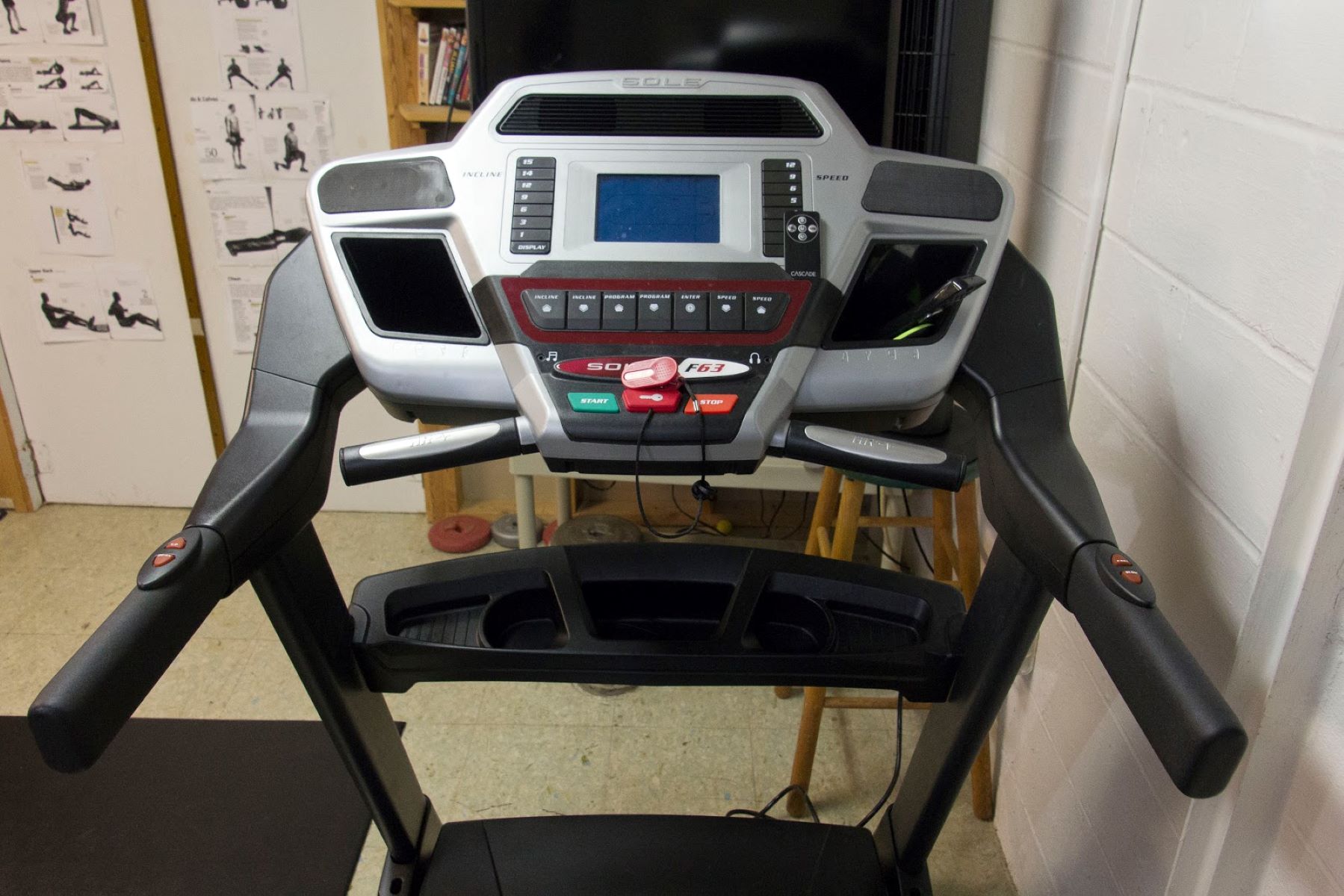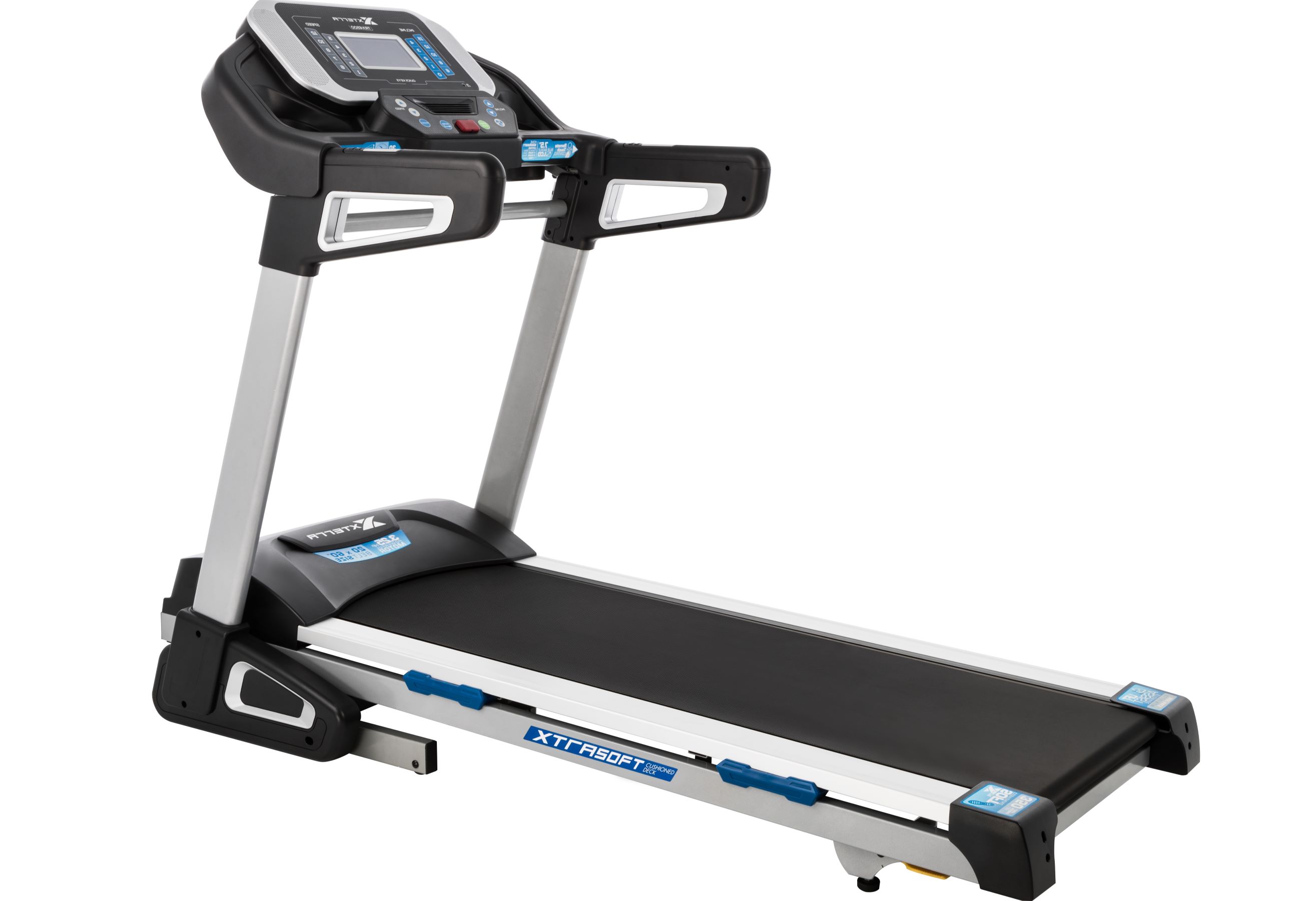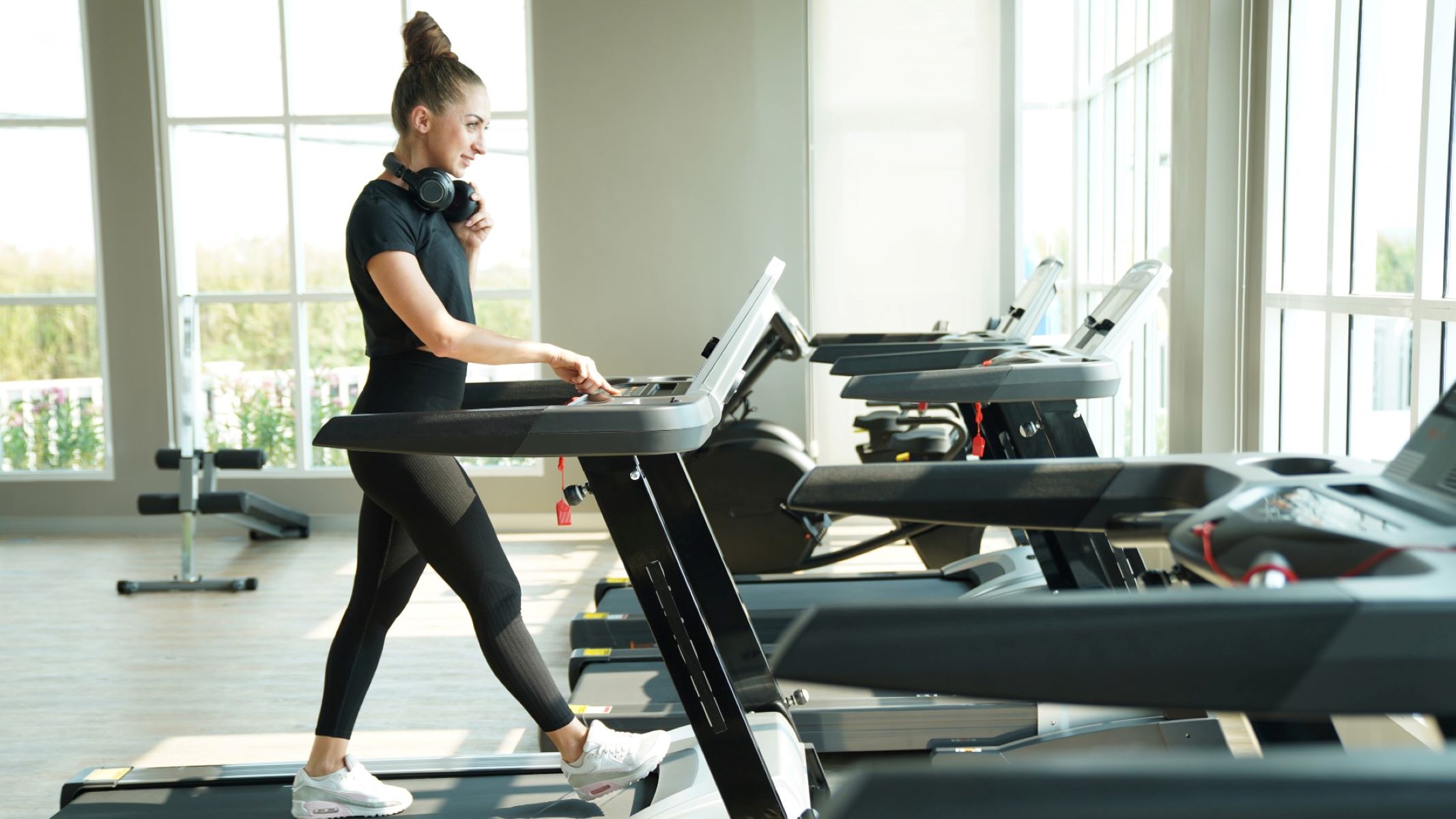

Featured
How To Workout On A Treadmill
Modified: August 21, 2023
Discover the ultimate guide on how to workout on a treadmill, featuring expert tips and effective exercises to boost your fitness regime.
Introduction
Welcome to the world of treadmill workouts! Whether you’re a beginner looking to start a fitness routine or a seasoned athlete looking for a convenient indoor exercise option, the treadmill is an excellent choice.
Working out on a treadmill provides numerous benefits, such as improving cardiovascular health, burning calories, and building endurance. Plus, it’s a versatile piece of equipment that allows you to customize your workouts to suit your goals and fitness level.
In this article, we’ll guide you through everything you need to know about working out on a treadmill. We’ll cover topics such as choosing the right treadmill, setting it up properly, and designing effective workout routines. By the end, you’ll have all the knowledge and tools you need to embark on a successful treadmill workout journey.
Before we dive into the specifics, it’s important to note that safety should always be your top priority. Make sure to consult with your healthcare provider before starting any new exercise regimen, especially if you have any medical conditions or are recovering from an injury.
Additionally, it’s essential to listen to your body and work at a pace that is comfortable for you. Gradually increase the intensity and duration of your workouts over time, and stop immediately if you experience any pain or discomfort.
Now, let’s get started on this fitness adventure and explore the wonderful world of treadmill workouts!
Choosing the Right Treadmill
With so many treadmill options on the market, selecting the right one for your needs might seem overwhelming. However, by considering a few key factors, you can find the perfect treadmill that will help you achieve your fitness goals.
The first thing to consider is your budget. Treadmills come in a wide range of prices, so determine how much you’re willing to invest in your fitness equipment. It’s important to strike a balance between quality and affordability.
Next, think about the space you have available. Measure the area where you plan to place the treadmill and ensure that the dimensions of the treadmill align with your available space. Consider whether you need a foldable treadmill for easy storage.
Another important factor is the weight capacity of the treadmill. Look for a treadmill that can support your weight to ensure stability and safety during your workouts. Additionally, check the motor power and speed range to ensure it meets your exercise requirements.
Consider the features and programs offered by the treadmill. Advanced features such as incline adjustment, pre-set workout programs, heart rate monitoring, and connectivity options can enhance your workout experience.
Reading customer reviews and ratings can provide valuable insights into the durability, performance, and overall quality of the treadmill. Look for reviews from verified buyers and consider both positive and negative feedback.
Lastly, don’t forget about warranties and customer support. A reliable warranty can give you peace of mind in case of issues with your treadmill. Check if the manufacturer offers responsive customer support for any queries or troubleshooting.
By considering these factors, you can narrow down your options and find the perfect treadmill that fits your budget, space, and fitness needs. Remember, investing in a quality treadmill will contribute to a safer and more enjoyable workout experience.
Setting Up Your Treadmill
Once you’ve selected the perfect treadmill, the next step is to set it up correctly to ensure proper functionality and safety. Follow these steps to get your treadmill ready for a successful workout:
1. Find a suitable location: Choose a well-ventilated area with enough space around the treadmill for easy movement. Ensure that the floor is level and stable to prevent any wobbling during your workouts.
2. Assemble the treadmill: Carefully follow the manufacturer’s instructions to assemble your treadmill. Double-check all the screws, bolts, and connections to ensure everything is secure and properly tightened.
3. Adjust the settings: Set the treadmill settings according to your preferences. Adjust the speed, incline, and any other settings based on your fitness level and workout routine.
4. Lubricate the belt: Check the manufacturer’s instructions on how to properly lubricate the treadmill belt. Regular lubrication ensures smooth movement and prolongs the life of the treadmill.
5. Plug in and power on: Connect the treadmill to a power source and switch it on. Most treadmills have a safety key that needs to be attached for the treadmill to function. Make sure it’s properly inserted.
6. Familiarize yourself with the console: Take some time to explore the console and understand the various functions and features. Learn how to adjust the speed, incline, and other settings to optimize your workouts.
7. Start with a test walk: Begin with a slow walk to ensure that the belt is running smoothly and that you feel comfortable on the treadmill. Make any necessary adjustments to the speed, incline, or settings as needed.
8. Check for stability and safety: Ensure that the treadmill is stable and doesn’t wobble during your workout. Make sure the handrails are secure and within easy reach if needed for balance or support.
By following these steps, you’ll have your treadmill set up and ready for an effective workout. Remember to always read the manufacturer’s instructions for specific guidelines on assembling and setting up your treadmill model.
Warm-Up Exercises
A proper warm-up is essential before starting any workout routine, including treadmill workouts. It helps prepare your muscles and joints for the upcoming intensity, reduces the risk of injury, and improves overall performance. Incorporate these warm-up exercises into your treadmill workout routine:
1. Walking or light jogging: Begin your warm-up by walking or lightly jogging on the treadmill for 5-10 minutes. Start at a comfortable pace to gradually increase your heart rate and warm up your muscles.
2. Dynamic stretches: Perform dynamic stretches to loosen up your muscles and increase flexibility. Include exercises such as leg swings, arm circles, high knees, and lunges. Perform each stretch for about 10-15 repetitions.
3. Hip openers: Stand beside the treadmill and swing one leg forward and backward, opening up your hips. Repeat this movement on both legs for about 10-15 repetitions to mobilize your hip joints.
4. Leg swings: Stand beside the treadmill and swing one leg forward and backward, keeping it straight. Repeat this movement on both legs for about 10-15 repetitions to loosen up your hamstrings and hip flexors.
5. Arm circles: Stand in an upright position and extend your arms out to the sides. Make circular motions with your arms, gradually increasing the size of the circles. Perform 10-15 arm circles in both clockwise and counterclockwise directions.
6. Lunges: Step forward with one foot while keeping the other foot stationary. Lower your body by bending both knees to form a lunge position. Alternate legs and perform 10-15 lunges on each side to activate your leg muscles.
Remember to perform these warm-up exercises in a controlled and comfortable manner. Listen to your body and adjust the intensity as needed. If you have any specific areas of tightness or stiffness, add additional stretches to target those muscles.
By incorporating these warm-up exercises into your treadmill workouts, you’ll prepare your body for the upcoming intensity and reduce the risk of injury. Remember, warm-up exercises should be done at a moderate intensity and gradually build up to the main workout.
Basic Treadmill Workout Routine
Now that you’ve warmed up, it’s time to dive into a basic treadmill workout routine. This routine is suitable for beginners and provides a great cardiovascular workout. Follow these steps to get started:
1. Start with a brisk walk: Begin by setting the treadmill to a moderate walking pace. Aim for a pace where you can maintain a conversation comfortably. Walk for 5-10 minutes to gradually increase your heart rate and warm up your muscles.
2. Pick up the pace: After your warm-up, increase the speed to a light jog or a faster walking pace. Find a comfortable speed that challenges you but allows you to maintain good form and breathing. Jog for 5-10 minutes to elevate your heart rate and build endurance.
3. Introduce intervals: To add variety and increase the intensity of your workout, incorporate intervals. Alternate between periods of higher intensity and lower intensity. For example, sprint for 30 seconds, followed by a 1-minute walk or jog to recover. Repeat the intervals for 10-15 minutes.
4. Gradual cool-down: After completing your intervals, gradually decrease the speed and return to a brisk walk. Walk for 5-10 minutes to gradually bring your heart rate down and allow your muscles to recover.
5. Stretching: Finish your treadmill workout with a series of static stretches. Focus on stretching your major muscle groups, including your legs, hips, back, and shoulders. Hold each stretch for 15-30 seconds and breathe deeply to enhance flexibility and aid in recovery.
As a beginner, it’s important to listen to your body and work at a pace that is comfortable for you. Adjust the speed and intensity to match your fitness level and gradually increase as you become more comfortable and fit.
Remember to stay hydrated throughout your workout and make any necessary adjustments to the treadmill settings or pace to ensure a safe and effective workout.
By following this basic treadmill workout routine, you’ll improve your cardiovascular endurance, burn calories, and build strength over time. It’s a great starting point for beginners to establish a regular exercise habit and progress toward more advanced workouts.
Interval Training on the Treadmill
Interval training is a highly effective and efficient way to maximize your treadmill workouts. It alternates between periods of high-intensity exercise and active recovery, allowing you to push your limits, improve cardiovascular fitness, and burn calories. Here’s how to incorporate interval training into your treadmill routine:
1. Warm up: Begin with a brisk walk or light jog for 5-10 minutes to warm up your muscles and gradually increase your heart rate.
2. Set your intervals: Determine the duration and intensity of your high-intensity intervals. For beginners, start with shorter intervals of higher intensity, such as 30 seconds to 1 minute. Adjust the speed and incline of the treadmill accordingly.
3. High-intensity intervals: Increase the speed and intensity to a challenging level and sprint or run at your maximum effort during the specified interval. This should make you breathless and increase your heart rate significantly. Push yourself during this time, but remember to maintain proper form and control.
4. Active recovery: After each high-intensity interval, engage in active recovery. Reduce the speed and intensity to a comfortable level, allowing your heart rate to come down while still maintaining movement. This could involve walking or jogging at a moderate pace.
5. Repeat the intervals: Continue alternating between high-intensity intervals and active recovery for a total of 10-20 minutes, depending on your fitness level and goals. Aim to challenge yourself, but listen to your body and adjust the intensity as needed.
6. Cool down: After completing your intervals, gradually decrease the speed and intensity to return to a brisk walk. Walk for 5-10 minutes to bring your heart rate down and allow your muscles to recover.
Interval training offers numerous benefits, including increased calorie burn, improved cardiovascular fitness, and enhanced endurance. It’s a time-efficient way to get a challenging workout in a shorter amount of time.
You can modify your interval training by adjusting the speed, duration, and incline of your intervals. As you progress and become more comfortable, you can increase the duration of your high-intensity intervals and decrease the duration of your recovery periods.
Remember to stay hydrated throughout your workout and always prioritize safety. If you’re new to interval training or have any underlying health conditions, consult with a healthcare professional before incorporating high-intensity exercises into your routine.
By incorporating interval training into your treadmill workouts, you’ll elevate the intensity and effectiveness of your workouts and achieve greater fitness results in less time.
Adding Incline for a Challenge
If you’re looking to intensify your treadmill workouts and target different muscle groups, adding incline is a fantastic way to do so. Incorporating incline intervals into your routine not only increases the challenge but also helps build strength and endurance. Here’s how to add incline for a more challenging treadmill workout:
1. Warm up: Begin with a 5-10 minute warm-up, which can include walking or light jogging at a flat incline. This will prepare your muscles and gradually increase your heart rate.
2. Familiarize with the controls: Understand the incline controls on your treadmill. Most treadmills offer a range of incline options, typically going up to 10-15%. Familiarize yourself with the buttons or settings that adjust the incline.
3. Start with a moderate incline: Begin your incline workout by setting the treadmill to a moderate incline, around 3-4%. This slight elevation engages different muscle groups, especially your glutes and hamstrings.
4. Increase the incline: After a few minutes of walking or jogging at a moderate incline, gradually increase the incline to a higher level, such as 5-8%. This will further engage your leg muscles, increase your heart rate, and intensify your workout.
5. Incorporate incline intervals: To make your workout more challenging and varied, include incline intervals. Alternate between periods of elevated incline and periods of recovery at a lower incline or flat surface.
6. Intensity and duration of intervals: Adjust the intensity and duration of your incline intervals based on your fitness level and goals. For example, you can increase the incline to 10% and walk or jog for 1-2 minutes, followed by a recovery period at a flatter incline or flat surface.
7. Gradual cool-down: After completing your incline intervals, gradually reduce the incline to a flat surface and decrease the speed. Walk for 5-10 minutes to cool down and allow your muscles to recover.
By adding incline to your treadmill workout, you’ll not only challenge your muscles and cardiovascular system but also simulate outdoor running or hiking. It helps build strength in your lower body, particularly in your glutes, quadriceps, and calves.
Listen to your body and adjust the incline and intensity as needed. If you’re just starting, begin with a lower incline and gradually increase it over time as your fitness level improves. Remember, safety and proper form are essential when using incline, so focus on maintaining good posture and engaging the correct muscles.
Adding incline can provide a significant boost to your treadmill workouts, making them more challenging and effective. It adds variety and helps prevent plateauing in your fitness routine, keeping you motivated and engaged.
Monitoring Your Heart Rate
Monitoring your heart rate during treadmill workouts is a valuable tool to gauge your exercise intensity and ensure that you’re maximizing the benefits of your workout. Understanding and maintaining the appropriate heart rate range can help you achieve your fitness goals more effectively. Here’s how to monitor your heart rate during your treadmill workouts:
1. Calculate your target heart rate range: Determine your target heart rate range based on your age and fitness level. Subtract your age from 220 to estimate your maximum heart rate, and then calculate the lower and upper limits of your target heart rate range. For moderate-intensity workouts, aim for 50-70% of your maximum heart rate, and for higher intensity workouts, aim for 70-85%.
2. Wear a heart rate monitor: Invest in a heart rate monitor device or use the built-in heart rate sensors on some treadmills to accurately monitor your heart rate. These devices provide real-time feedback and help you stay within your target heart rate zone.
3. Use the heart rate chart: Familiarize yourself with a heart rate chart that correlates heart rate ranges with different exercise intensities. This will help you determine whether you’re within your target heart rate zone. Adjust the speed and incline on the treadmill accordingly to reach and maintain your desired heart rate range.
4. Pay attention to your body’s signals: Monitoring your heart rate is important, but it’s also crucial to listen to your body. Pay attention to other signs such as perceived exertion and how you feel during your workout. If you’re feeling excessively fatigued, experiencing shortness of breath, or feeling lightheaded, it may be a sign to reduce the intensity of your workout.
5. Adjusting your workout intensity: Based on your heart rate feedback and how you feel, you can adjust the speed and incline on the treadmill to ensure that you stay within your target heart rate range. Increase the intensity to reach the higher end of your target range for more challenging workouts or decrease the intensity if your heart rate is consistently above your desired range.
6. Track your progress: Regularly monitor and track your heart rate during your treadmill workouts. Over time, you’ll notice improvements in your cardiovascular fitness as your heart rate becomes more efficient during exercise. This progress can help motivate and guide your future workouts.
Monitoring your heart rate during treadmill workouts allows you to tailor your workouts to your fitness level and goals. It helps you optimize your exercise intensity, ensuring that you’re working hard enough to see results without overexerting yourself.
Remember, it’s important to consult with a healthcare professional if you have any heart conditions or concerns about monitoring your heart rate during exercise.
By incorporating heart rate monitoring into your treadmill workouts, you’ll have a better understanding of your exercise intensity and be able to make adjustments as needed. This will help you achieve your fitness goals more effectively and efficiently.
Cooling Down and Stretching
After completing a challenging treadmill workout, it’s essential to cool down and stretch your muscles. Cooling down allows your heart rate and breathing to gradually return to normal, while stretching helps to improve flexibility and prevent muscle soreness. Here’s how to properly cool down and stretch after your treadmill session:
1. Gradual cooldown: Gradually reduce the speed and incline of the treadmill to a slow walk. Walk for 5-10 minutes at a comfortable pace to allow your heart rate to gradually lower and to promote recovery.
2. Deep breathing: Take deep breaths in through your nose and slowly exhale through your mouth. This will help you relax and aid in bringing your body back to its resting state.
3. Whole-body stretches: Perform whole-body stretches to target major muscle groups. Start with your neck, rolling it gently from side to side and stretching it in different directions. Move on to your shoulders, arms, chest, back, hips, legs, and calves. Hold each stretch for 15-30 seconds and avoid bouncing or jerking movements.
4. Focus on tight areas: If you have specific areas of tightness or soreness, give them extra attention during your post-workout stretch. Stretching these areas gently and holding the stretch can help release tension and promote recovery.
5. Use various stretching techniques: Incorporate a combination of static stretches, where you hold a stretch in a fixed position, and dynamic stretches, where you move through a range of motion. This will enhance overall flexibility and provide a balanced stretch to your muscles.
6. Listen to your body: Pay attention to any discomfort or pain during your stretching. Stretching should not cause pain, but you might feel a mild pulling or tension sensation. If you experience any sharp or intense pain, stop immediately and consult with a healthcare professional.
7. Hydration: Drink plenty of water after your workout to replenish fluids lost during exercise. Staying hydrated aids in muscle recovery and overall well-being.
By cooling down and stretching properly after your treadmill workout, you can help reduce muscle soreness and minimize the risk of injury. It also promotes relaxation and aids in the recovery process.
Remember, stretching should be performed when your muscles are warm, so immediately after your workout is an ideal time. If you have specific flexibility goals or areas of concern, consider incorporating regular stretching sessions into your routine on non-workout days as well.
Take the time to properly cool down and stretch after your treadmill workouts, and your body will thank you for it. It’s an essential part of a well-rounded and effective exercise routine.
Tips for a Successful Treadmill Workout
To make the most of your treadmill workouts and ensure a successful experience, consider these tips that will enhance your performance and keep you motivated:
1. Set specific goals: Determine your fitness goals, whether it’s improving endurance, burning calories, or training for a race. Setting clear goals will help you stay focused and motivated during your treadmill workouts.
2. Vary your workouts: Keep your workouts exciting and prevent boredom by incorporating different workout formats. This could include intervals, hill climbs, tempo runs, or even virtual scenic routes. Variety will challenge your body and mind.
3. Incorporate strength training: Combine your treadmill workouts with strength training exercises to build overall body strength and improve running efficiency. Include exercises such as lunges, squats, planks, and push-ups within your routine.
4. Use proper form: Maintain good posture while running on the treadmill. Keep your head up, shoulders relaxed, and arms swinging naturally. Land with a midfoot strike and use your arms to assist with forward momentum.
5. Listen to music or podcasts: Create a playlist of upbeat songs or listen to podcasts to keep yourself entertained and motivated during your workouts. Music can boost your mood and distract you from any discomfort.
6. Stay hydrated: Drink water before, during, and after your treadmill workout to stay hydrated. Even though you’re indoors, you can still lose fluids through sweat, so be mindful of your hydration levels.
7. Wear proper footwear: Invest in a pair of running shoes that provide adequate cushioning and support for your feet. Wearing the right footwear can prevent discomfort and reduce the risk of injuries.
8. Engage in post-workout recovery: After your treadmill workout, focus on post-workout recovery techniques such as stretching, foam rolling, or even using a massage gun. This aids in muscle recovery and reduces post-workout muscle soreness.
9. Track your progress: Keep a journal or use a fitness app to track your treadmill workouts. Monitor your times, distances, and any improvements you notice over time. This will provide a sense of accomplishment and keep you motivated.
10. Prioritize rest days: Allow your body ample time to recover and avoid overtraining. Schedule regular rest days to give your muscles and joints a chance to rest and repair.
By following these tips, you can maximize the effectiveness of your treadmill workouts and make them enjoyable and rewarding. Remember to listen to your body, adjust the intensity as needed, and always prioritize safety and proper form.
Conclusion
Congratulations! You’ve reached the end of our comprehensive guide to working out on a treadmill. By now, you should have a good understanding of how to choose the right treadmill, set it up properly, and design effective workout routines to achieve your fitness goals.
Working out on a treadmill offers numerous benefits, including cardiovascular improvement, calorie burning, and the convenience of exercising indoors. Whether you’re a beginner or a seasoned athlete, the treadmill can be customized to challenge and suit your fitness level.
Remember to prioritize safety throughout your treadmill workouts. Consult with your healthcare provider before starting a new exercise regimen, listen to your body, and start slowly if you’re a beginner. Gradually increase the intensity and duration of your workouts to prevent overexertion and reduce the risk of injuries.
Incorporating warm-up exercises, varying your workout routines, adding incline, monitoring your heart rate, and cooling down with stretching are all important components to optimize your treadmill workouts. These elements contribute to a well-rounded and effective exercise routine that will yield results and keep you motivated.
Lastly, listen to your body and make adjustments as needed. Each person is unique, so customize your treadmill workouts to suit your fitness level, goals, and preferences. Stay consistent, challenge yourself, and enjoy the benefits of this versatile piece of fitness equipment.
Now it’s time to put your newfound knowledge into action. Lace up your shoes, step onto that treadmill, and embark on your fitness journey with confidence and determination. Remember, consistency is key, and every step you take brings you closer to your health and wellness goals.
